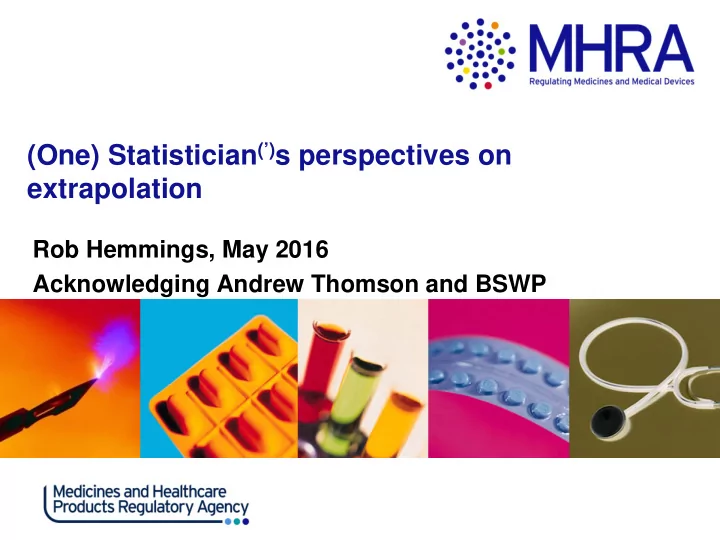

(One) Statistician (’) s perspectives on extrapolation Rob Hemmings, May 2016 Acknowledging Andrew Thomson and BSWP
Context • There are strong methodological principles that underpin clinical trial design • There are also ‘usual’ methodological standards for ‘success criteria’ that underpin regulatory decision making • To talk about extrapolation there must be some a priori rationale, based on development in adults, that a safe and efficacious dose exists in children • This is a different starting point to establishing evidence of efficacy de novo • Therefore, it might be possible to have different approaches to clinical trial design and success criteria, without reducing standards
Context • The paper presents a framework for this exercise, but not a recipe book. • Huff et al. How to lie with Statistics – Huff proposed a series of questions to be asked: • Who says so? (Does he/she have an axe to grind?) • How does he/she know? (Does he/she have the resources to know the facts?) • What’s missing? (Does he/she give us a complete picture?) • Did someone change the subject? (Does he/she offer us the right answer to the wrong problem?) • Does it make sense? (Is his/her conclusion logical and consistent with what we already know?)
Extrapolation Concept • In order to justify this advanced ‘starting point’, knowledge should be systematically quantified, synthesised and presented • Importantly, this exercise should complement a systematic consideration and identification of the areas that are important for decision making where knowledge is currently lacking
Extrapolation Concept (aside) • ? Even in situations when the scientific justification is weak, if a full study programme is not feasible, the exercise has merit as part of the wider understanding of any data that is ultimately generated.
Extrapolation Plan • One model… – Understand PK/PD → efficacy in adults – ‘Assume’ PD → efficacy in children – Generate PK/PD in children • Another model… – Evidence of efficacy in adults – ‘Assume’ similar pharmacology and disease progression in children – Generate reduced clinical package of efficacy in children
Extrapolation Plan • PK / PD understanding will sometimes be sufficient but other times may not • The better the understanding of the link between PD → efficacy, the more weight can be given to PD, and hence potentially PK • Assessment of the relationship between PD → efficacy, and the related decision on the evidence to be generated, is made in committees with a broad expertise • Clinicians, modellers, statisticians; no one discipline should work alone in extrapolation
Extrapolation Plan • Useful statistical principles relating to ‘Model 1’ – Pre-specification of data generation – Pre-specification of analytic approach – Pre-specification of success criteria – GMP and checks of ‘robustness’ to assumptions • Approaches good for quantification (of what is known to date) might be open to error or abuse in terms of confirmation.
Extrapolation Plan • Challenges relating to ‘Model 2’ – How to summarise, use and communicate information generated to date; – How to quantitatively define what the right hurdle is based on the information generated to date • Not a call to all suddenly become Bayesian
Extrapolation Plan • Limited regulatory experience in use of Bayesian methods – What type of ‘prior’ (priors, meta-analytic priors, power priors… data, opinions, value judgements…) – How to ‘weight’ the ‘prior’ – Avoid ‘double-counting’ in interpretation – Should be able to describe, in an interpretable way, a priori, what success looks like.
Confirmation and Extrapolation • Confirm similarity in pharmacology, through model validation, and predictions in disease progression and hence in clinical response. • Document and address assumptions and uncertainties. • Complete the extrapolation ‘package’, addressing all important questions and uncertainties, or iterate the proposal. • Consider whether and how to address further the important residual uncertainties, realising that not all questions can be answered in all trial designs / data sources, in particular not post-authorisation.
An aside from SAWP • Multi-disciplinary, working with MSWG, BSWP, PDCO (joint members and co-ordinator) and CHMP (joint members) • A good forum for preparatory and continuing (iterating) discussions • Benefits to building experience together
Conclusions • What do I know? • What questions should be addressed … using which approach … … and what methods … that are based on which assumptions? • What criteria should I pre-specify for success … and to justify that results are robust to important assumptions? Why? • Do I have a complete extrapolation package? If not, what to do next? • What residual uncertainties remain … how can these be addressed… and when?
Conclusions • A framework to plan and discuss minimising studies in children if the prevailing data and scientific understanding is such that the scientific questions of interest can be properly addressed through available evidence • Different clinical trial design and success criteria but statistical principles remain important • Approaches to quantification would benefit from further research, refinement and experience: – How to summarise, use and communicate information generated to date; – How to quantitatively define what the right hurdle is based on the information generated to date; – How to specify and justify success criteria, in particular if working outside the Frequentist RCT space; – What evidence to validate assumptions made. • To be implemented by all disciplines, across the work of CHMP, PDCO and SAWP.
Recommend
More recommend